In April, the U.S. Environmental Protection Agency (EPA) announced the first conventional pesticide tolerance for hemp seed—a significant success for The IR-4 Project and hemp growers seeking more pest management tools. Ethalfluralin, a conventional herbicide already used on crops like soybeans, peanuts and potatoes, will help hemp growers manage annual broadleaf and grassy weeds that compete with young plants. While there were already bio-based pesticides registered for use on hemp, growers have voiced a need for more tools in their toolbox to grow hemp successfully, especially at a larger scale.
“Having another tool in our very small IPM toolbox for hemp is critical,” shared Dr. David Suchoff, Alternative Crops Extension Specialist at North Carolina State University. “Weeds, especially in the Southeast, pose our biggest challenge…our small-plot trials utilize ethalfluralin, and we have seen excellent weed control (except for certain weeds like nutsedge, which the product will not manage).”
After the 2018 Farm Bill authorized the production of hemp, and removed hemp and hemp seeds from the controlled substance list, interest in growing the crop skyrocketed. With this hype around hemp came the demand for approved pest management tools. IR-4 is working with partner agencies and researchers to generate data and facilitate the registration of products to meet hemp growers’ needs, and this ethalfluralin tolerance marks the first success.

The Ethalfluralin Tolerance Process
Determining how to approach the regulation of pest management products for hemp posed a significant challenge to EPA. Since hemp is a relatively new crop (with scores of possible uses), EPA was uncertain about what residue studies would look like, what parts of the plant to study, and what kinds of risks would need to be assessed. It was (and still is) new territory.
According to Nancy Fitz, Minor Use Team Leader at EPA’s Office of Pesticide Programs, EPA needed IR-4’s expertise to navigate this uncertain landscape; IR-4 filled an essential niche.
IR-4 got to work gathering data that could be reasonably extrapolated to help EPA assess potential risks associated with using ethalfluralin on hemp seed. Some of the data came from studies done in Canada; IR-4’s longstanding collaborative relationship with the Canadian Pest Management Centre helped expedite the data gathering and petition process.
“We ended up taking Canadian data and writing a ChemSAC proposal asking EPA to consider, based on the weight of evidence, that there wouldn’t be any residue in the hemp harvest after the use of ethalfluralin,” explained Jerry Baron, Executive Director of The IR-4 Project. “This compound never had residues in plants—it didn’t translocate.”
In October 2020, IR-4 submitted its petition to EPA requesting tolerances be established for residues of ethalfluralin on hemp seed and several other crops. Based on IR-4’s petition, EPA issued a final rule on April 10th establishing these tolerances.
This new tolerance on hemp seed follows a robust human health risk assessment by EPA. According to the agency, “EPA’s tolerance for residues of ethalfluralin in or on hemp seed is based on carefully considered scientific rationale using ethalfluralin residue field trial data from several other crops. This new use of ethalfluralin on hemp is not expected to pose any unreasonable risks to people or the environment. ”
EPA has already accepted new ethalfluralin labels containing directions for use on hemp seed and other crops. Still, growers must wait until the product label is updated before using it on hemp. The maximum waiting period for this label update is 18 months. After 18 months, Sonalan HFP (101-63-356) that is distributed or sold must bear the approved labeling.
To learn more about EPA’s ethalfluralin tolerance, view the final rule and scientific analysis in docket EPA-HQ-OPP-2021-0130 at www.regulations.gov.
IR-4’s Role in Hemp’s Evolving Pest Management Needs
Compared to other crops, hemp is in its infancy in terms of data, experience, and regulatory preparedness to grow it at scale. IR-4 is hard at work—along with Cooperative Extension and land-grant researchers across the country—exploring pest management strategies to support hemp growers in this emerging industry.
Growing hemp for different uses (flower, fiber, seed, or feed) requires harvesting at different stages in the life cycle. This means farmers may encounter different pest challenges depending on their intended use or market. Weed management is the key issue in the seedling stage; once plants are established, their lush canopy can effectively shade out weeds. In the flowering stage, disease and insect pressure is more likely.
“Currently, IR-4 is looking at a range of products that will address foliar and root pathogens, mites, and grass weeds,” said Cole Smith, an IR-4 Field Research Director based at NC State University. “As the market shifts towards fiber, weeds are becoming more of a challenge for hemp growers.”
North Carolina-based hemp grower and agricultural consultant Bert James highlighted a disconnect between public perception of conventional pest management, and what growers need to make hemp work for them.
“There is a strong desire to keep hemp this fresh and clean crop, with limited need for pesticides, fungicides and herbicides. That doesn’t align with the farmers (at least not the range of farmers we have in our area),” shared James. “So it’s a bit of a disconnect—there’s a happy medium between these two groups and I like to be a reality check. With one residual application, we could grow hemp any time of the year; as it stands, we can’t plant anytime beyond mid-May because of the pigweed issues.”
In response to the ethalfluralin tolerance, James added, “The chemical toolbox for hemp will always be smaller because of the nature of the plant. What really needs to happen is for everyone to let it emerge as a crop that is healthy for rotations. Let it be just another crop we can invest in and further develop…let it breathe.”
Informed by the needs of growers, the ethalfluralin tolerance is a helpful step towards more successful hemp cultivation— particularly for larger-acreage production systems where efficient weed control is critical. While this tolerance is specifically for hemp seed (a food use), it lays the necessary groundwork for future tolerances supporting other potential end uses.
Hopeful for Hemp
“We’ve got a bunch of work in the books, and this is the first success,” said Baron, who is optimistic about the future of hemp, which holds potential not only for hemp seed and extract but also for fiber, construction materials, animal feed, soil remediation and more. “The bubble burst on hemp (for CBD), but it is going to make a comeback—there are all these different ways you can use it. The next step is getting more (pest management) products approved.”
Paving the way for these possibilities, IR-4 continues to prioritize and fund hemp field trials to develop data that growers and EPA need in the collective effort to shape a robust U.S. hemp industry. Next year, IR-4 is on track to submit the first petition containing actual hemp residue data, rather than data extrapolated from other crops. Stakeholders looking to suggest a hemp pest problem (or potential solution) to IR-4 for research may submit a Project Request; new hemp studies are prioritized every September at the Food Use Workshop.
The ethalfluralin tolerance on hemp seed is just the beginning of an improved and expanded pest management toolkit for hemp producers. IR-4 looks forward to the progress we are sure to witness as growers gain new tools for producing healthy crops.

Read More on Hemp
IR-4 Virtual Crop Tour: Hemp
NC State Extension Hemp Resources (including Dr. David Suchoff’s research)
About The IR-4 Project
The mission of the IR-4 Project is to facilitate regulatory approval of sustainable pest management technologies for specialty crops and specialty uses to promote public well-being. By working directly with local crop growers across the country, IR-4 conducts research and develops data necessary for the registration of pest management tools, ensuring that they are safe for use. To learn more, visit our website.
